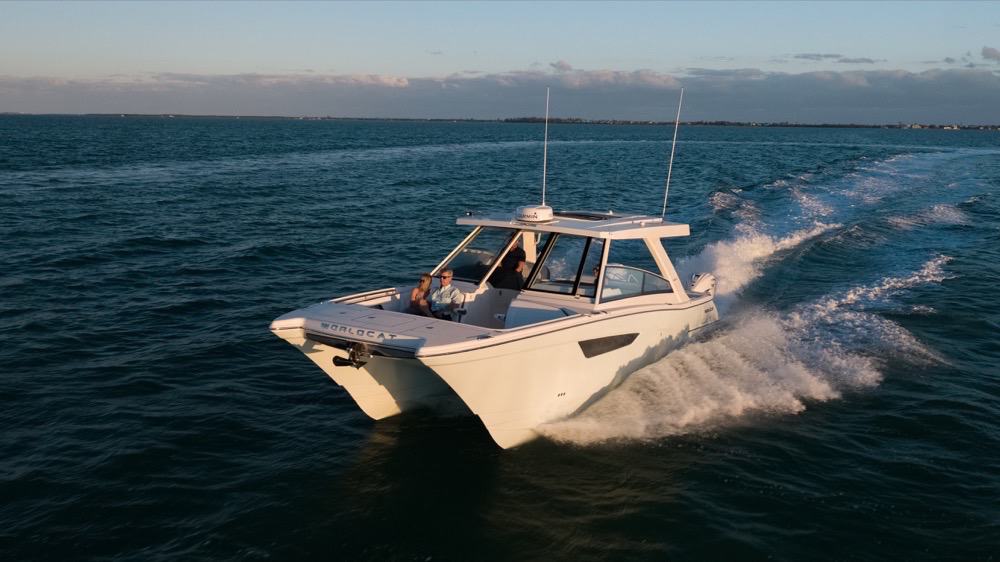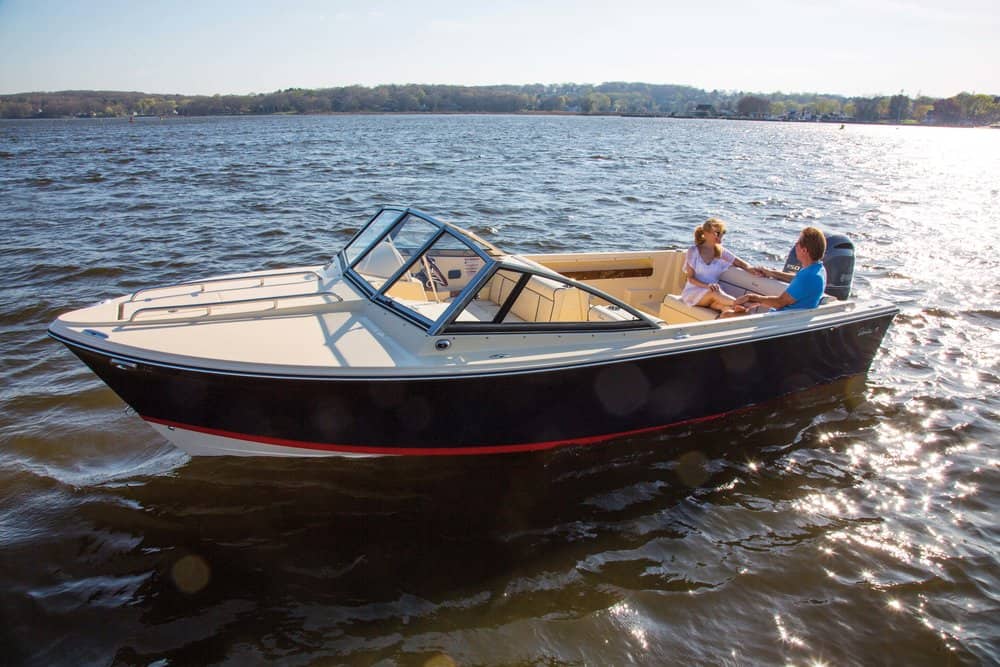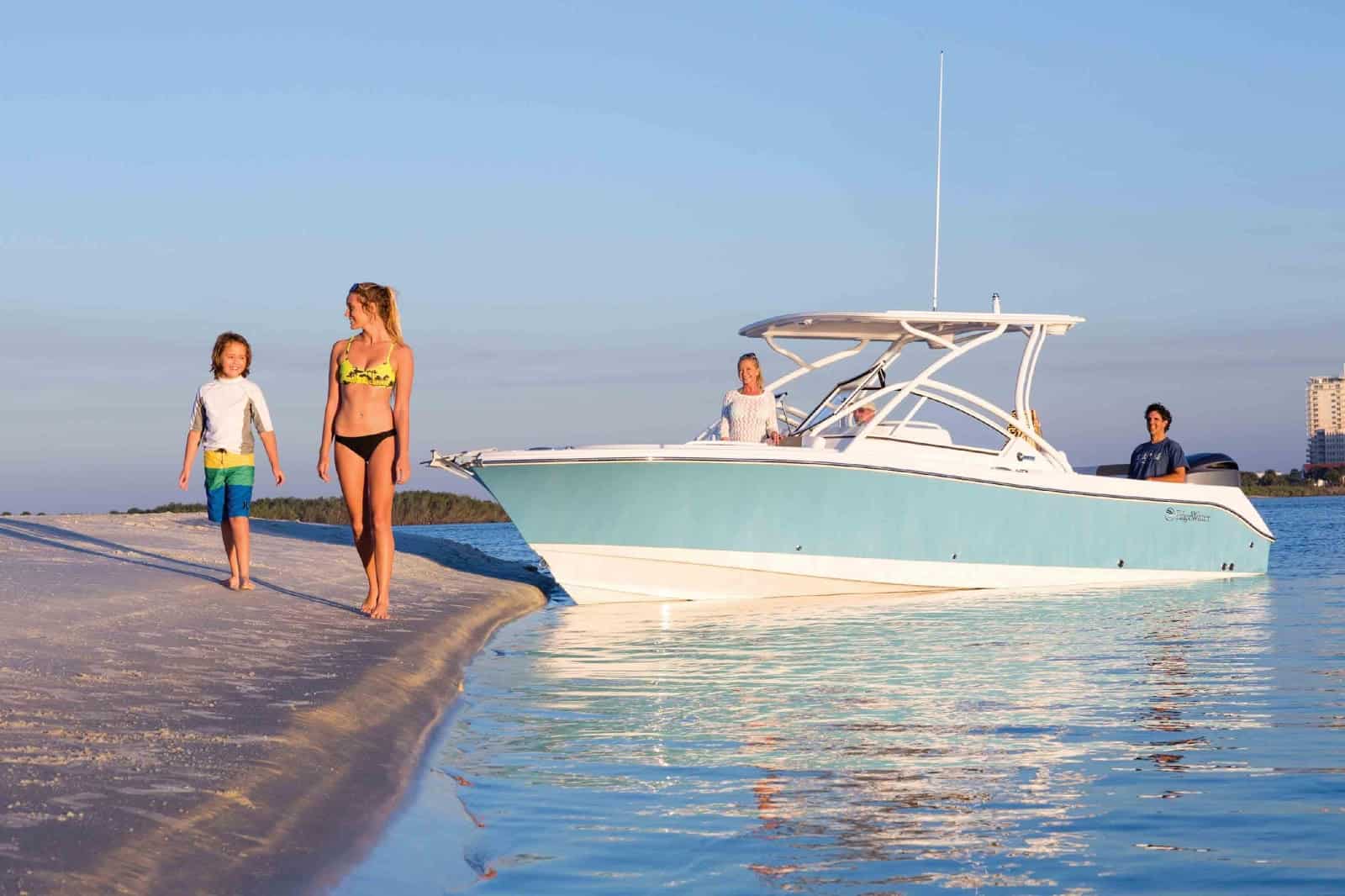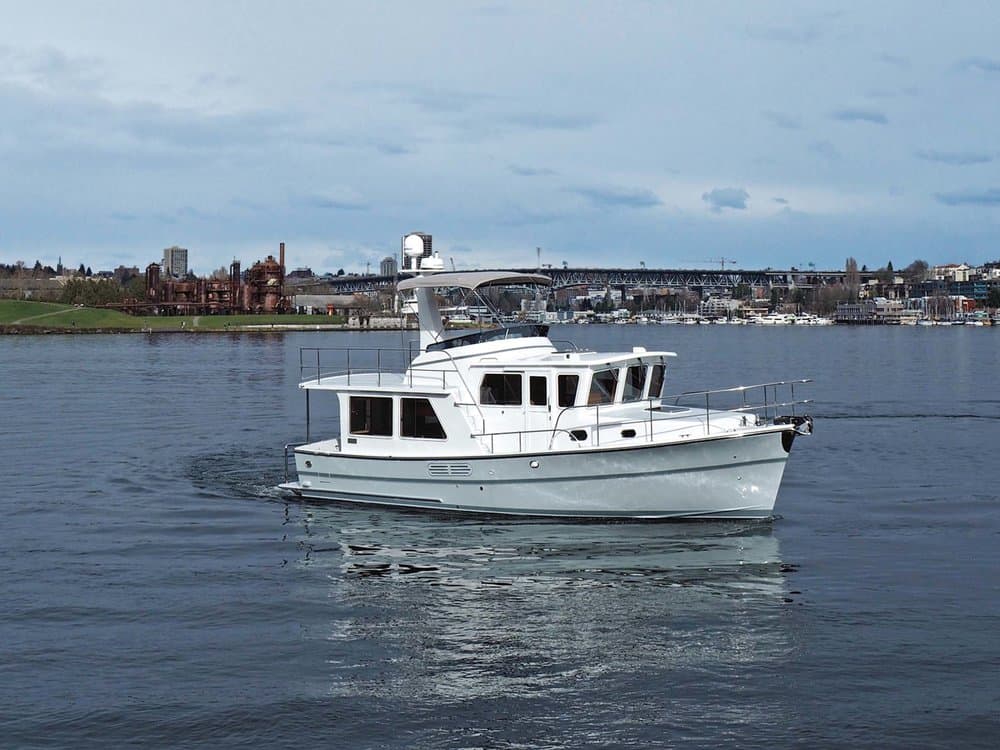World Cat’s 400 DC-X is an adventurous dayboat built to accommodate a dozen people in comfort and safety. It could be a seated lunch or dinner for eight adults, with four at the children’s table. How about a round-trip run for those dozen people from Norfolk to Smithfield for lunch, or Deltaville to Onancock, or Annapolis to Oxford, with a comfortable ride home despite in the afternoon’s three-foot chop? On even rougher days, it still offers safe passage for the crew.
Add in fuel efficiency at easy, long-legged cruising speeds of 20–30 mph (1.02–1.25 mpg), with twin Yamaha 425-hp XTO outboards and a top speed in the mid-40s, according to Yamaha’s Performance Bulletin. The horses in these big, sophisticated V-8 engines are Clydesdales, and their wide spacing on this catamaran provides excellent maneuverability in close quarters, especially when the boat is also equipped with Yamaha’s HelmMaster EX control system. By the way, those outboards and a draft of only 25 inches also make the 400DC-X readily beach-able at a favorite sandbar.
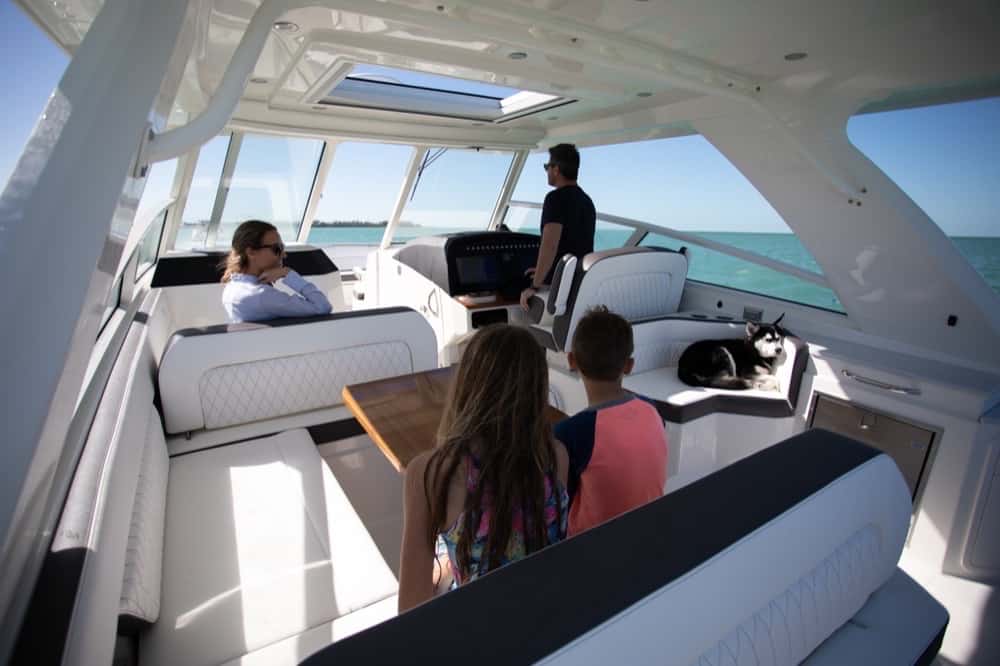
So what does it take to create a boat with all of these capabilities? For World Cat, it’s a commitment to power catamaran hulls. That’s all they do, in sizes ranging from 23 feet (for its intended purposes, the 23DC is one of the best multi-use family boats we’ve ever tested) up to this big rig, the company’s current flagship. Today, World Cat is the largest builder of power catamarans on Earth, with boats distributed globally, though the class really began its development in the rough waters of South Africa, Australia, and New Zealand in the 1970s and ’80s. The appeal of the basic design is the wave-splitting capability of its narrow hulls, which almost magically eliminates the jarring, pounding ride we associate with monohull boats being driven hard.
Some cat designs “sneeze” as the tunnel between the hulls blows incoming water back out and up, drenching the boats’ occupants as it moves forward. Some cats also lean outward, instead of inward, in turns, which can be unsettling at best and dangerous at worst.
Fortunately, World Cat’s design team has long experience with the range of cat designs, as well as sophisticated design software that allows them to draw, test, and produce hull forms that eliminate such bad habits, while maximizing lift with planing pads and strakes that also damp spray effectively both inside and outside. Watch carefully in the running videos (worldcat.com/models/400dc-x/videos/) to see how well they work. The lift allows high speed when needed but provides the 400DC-X great efficiency at “loping” speeds of 20–30 mph that are comfortable even in rough seas. Each World Cat’s VectorFlo tunnel between the hulls tapers inward going aft, so the combination of air and spray there accelerates rearward as the boat moves forward, creating a vacuum. The flowing mixture creates a cushion that helps to soften the ride. An “eyebrow” and a carefully shaped, molded pod just under the bow help accelerate airflow while damping any tendency to sneeze.
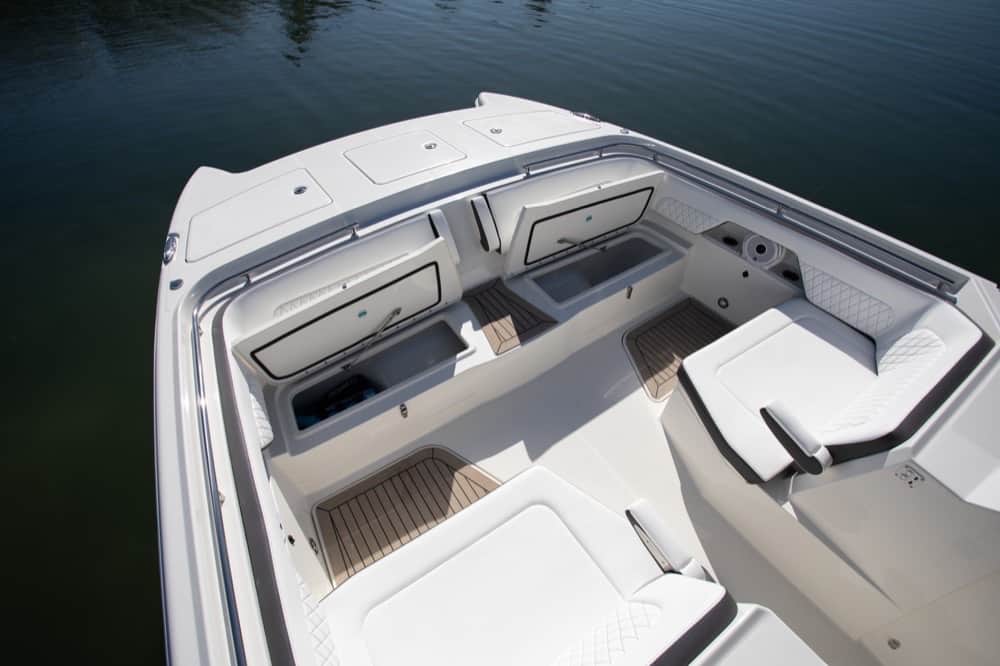
Design also includes careful analysis of how the boat’s prospective owners will use it, from the layout of interior features to a meticulous weight analysis looking into balance changes like people moving around and fuel consumption while the boat is underway. A prototyping team builds a mockup of the interior to test its effectiveness, providing feedback for the final design. The engineering team uses Finite Element Analysis to work out combinations of composite materials (gelcoat, resins, mat, knitted cloth, and foam core) that maximize strength and minimize weight. Skilled lamination teams (some members with 20 or more years’ experience) prepare the molds and build the hull, deck, and interior to replicate the intricate design. Last year, World Cat built a new plant dedicated to its larger models.
So what is it like to live with a 400DC-X? Well, that seated dinner for eight would employ the four doublewide seats in the huge bow, with two electrically controlled tables in between, which lower to the sole on command, freeing up space. Details in that space include strategically placed grab rails, cupholders, and storage beneath the forward seats and in hull-side pockets with 12-volt DC outlets. The bow deck has three hatches for access to the in-hull anchor, windlass, and washdown system. A bow shade is available for lazy days on the hook or at the beach. A sliding center windshield section and door beneath can close off the bow on rough or rainy days.
The dual consoles offer a berth to port and a head to starboard, both air-conditioned. The catamaran layout gives these two spaces a special asset: each has 6′ 5″ headroom. The berth measures 46″ x 74″, with storage drawers beneath. This cabin also holds a hanging locker with more drawers, the boat’s AC/DC electrical panel, a remote starting panel for the 8 kW Fischer Panda generator (under the cockpit sole), a microwave, flat-screen TV and soundbar, and side-mounted fishing rod storage. A hull-side window and an overhead skylight keep the space bright by day, with LED lighting at night. Under the helm, the starboard console holds a freshwater head with solar-powered vent, a holding tank with deck pumpout, a sink/vanity with LED lighting and storage, two 120-volt outlets, a walk-in enclosed shower with seat, another hanging locker, and a hull-side window.
A structurally integrated hardtop with sunroof covers the bridge deck, with air conditioning in the space below. Seating below includes doublewide cushions at the helm and to port. The back of the port companion seat can swing to face a U-shaped lounge aft of it, with the electrically articulated children’s table (which can lower to provide a doublewide pad). The back of the after seat in the lounge also swings forward to provide an aft-facing view for watching swimmers or tube riders. Two storage drawers pull out from this seat. The helm to starboard has a dash wide enough to accommodate an optional pair of 17-inch Garmin multi-function displays for linked sonar/GPS/chart/VHF/AIS/radar electronics, interfaced with the engines’ HelmMaster EX system. Aft of the helm is an entertainment center with seat (insulated cooler under), a drawer refrigerator, storage drawers, and a tilt-out trash can.
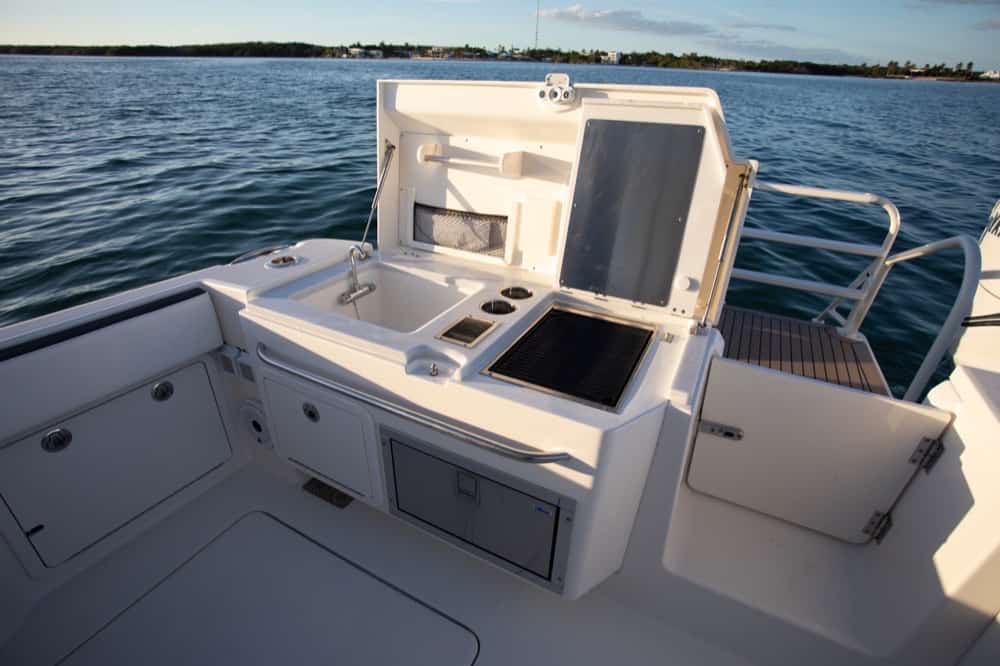
The aft cockpit is a space for both on-deck action and below-deck maintenance. The port hull-side holds a locking door for swimming and docking by floating piers. The transom is adaptable for various owner needs. Two options are a portside insert holding a 25-gallon livewell plus cooler and a starboard unit with a sink, a cutting board, an electric grill, and another drawer refrigerator. In between (another special catamaran feature) lies an aft deck extension with sturdy rails and a ladder for swimming and diving. There’s a pull-out hot/cold deck shower for swimmers.
In the cockpit sole, two large (i.e., adult human-sized) hatches give access to the batteries (three Group 31 house, two Group 27 cranking), an optional Glendinning shorepower reel for 50 amp service, an optional Seakeeper, and the generator with its 24-gallon fuel tank. Also under the port hatch are pumps and a sea chest with tunnel-side pickup for the bow and stern raw water washdowns. On both hull-sides are drainage collection manifolds for the self-draining decks. One last but welcome maintenance asset tucked into the starboard transom corner is a Reverso remote engine flushing system to keep the two Yamahas running happily for a long time.
Power catamarans shine in the areas they’re designed for. World Cat has a long track record of paying close attention to input from customers, sales associates, and service techs. World Cat offers a range of custom designs for the interior. MSRP for the 400 DC-X is $850,000, but that’s a base price. The well-equipped one we examined listed at $993,838. For more information, contact Bosun’s Marine, Grasonville, Md., a winner of World Cat awards for both sales and service (bosuns.com), or visit worldcat.com.

